engine CADILLAC DEVILLE 1996 7.G Owners Manual
[x] Cancel search | Manufacturer: CADILLAC, Model Year: 1996, Model line: DEVILLE, Model: CADILLAC DEVILLE 1996 7.GPages: 354, PDF Size: 20.32 MB
Page 281 of 354
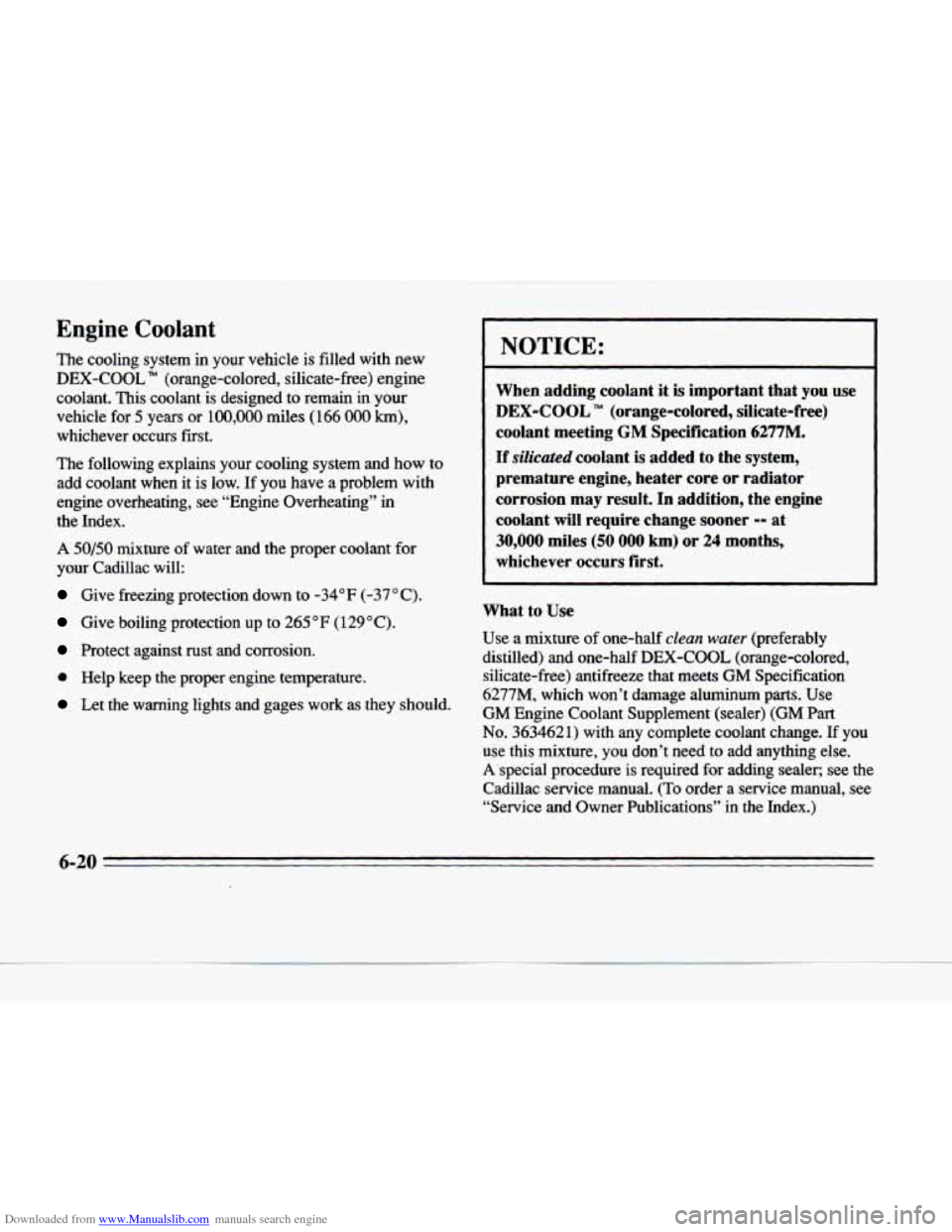
Downloaded from www.Manualslib.com manuals search engine Engine Coolant
The cooling system in your vehicle is filled with new
DEX-COOL (orange-colored, silicate-free) engine
coolant. This coolant is designed to remain in your vehicle for
5 years or 100,000 miles (166 0o0 km),
whichever occurs first.
The following explains your cooling system and how
to
add coolant when it is low. If you have a problem with
engine overheating, see “Engine Overheating” in
the Index.
A 50/50 mixture of water and the proper coolant for
your Cadillac will:
Give freezing protection down to -34°F (-37 O C).
Give boiling protection up to 265 “F (129 “C).
Protect against rust and corrosion.
0 Help keep the proper engine temperature.
Let the warning lights and gages work as they should.
NOTICE:
When adding coolant it is important that you use
DEX-COOL TM (orange-colored, silicate-free)
coolant meeting
GM Specification 6277M.
If silicated coolant is added to the system,
premature engine, heater core or radiator
corrosion may result. In addition, the engine
coolant
will require change sooner -- at
30,000 miles (50 000 km) or 24 months,
whichever occurs first.
What
to Use
Use a mixture of one-half clean water (preferably
distilled) and one-half
DEX-COOL (orange-colored,
silicate-free) antifreeze that meets
GM Specification
6277M, which won’t damage aluminum parts. Use
GM Engine Coolant Supplement (sealer) (GM Part
No. 3634621) with any complete coolant change. If you
use this mixture, you don’t need
to add anything else.
A special procedure is required for adding sealer; see the
Cadillac service manual.
(To order a service manual, see
“Service and Owner Publications”
in the Index.)
6-20 Y
Page 282 of 354
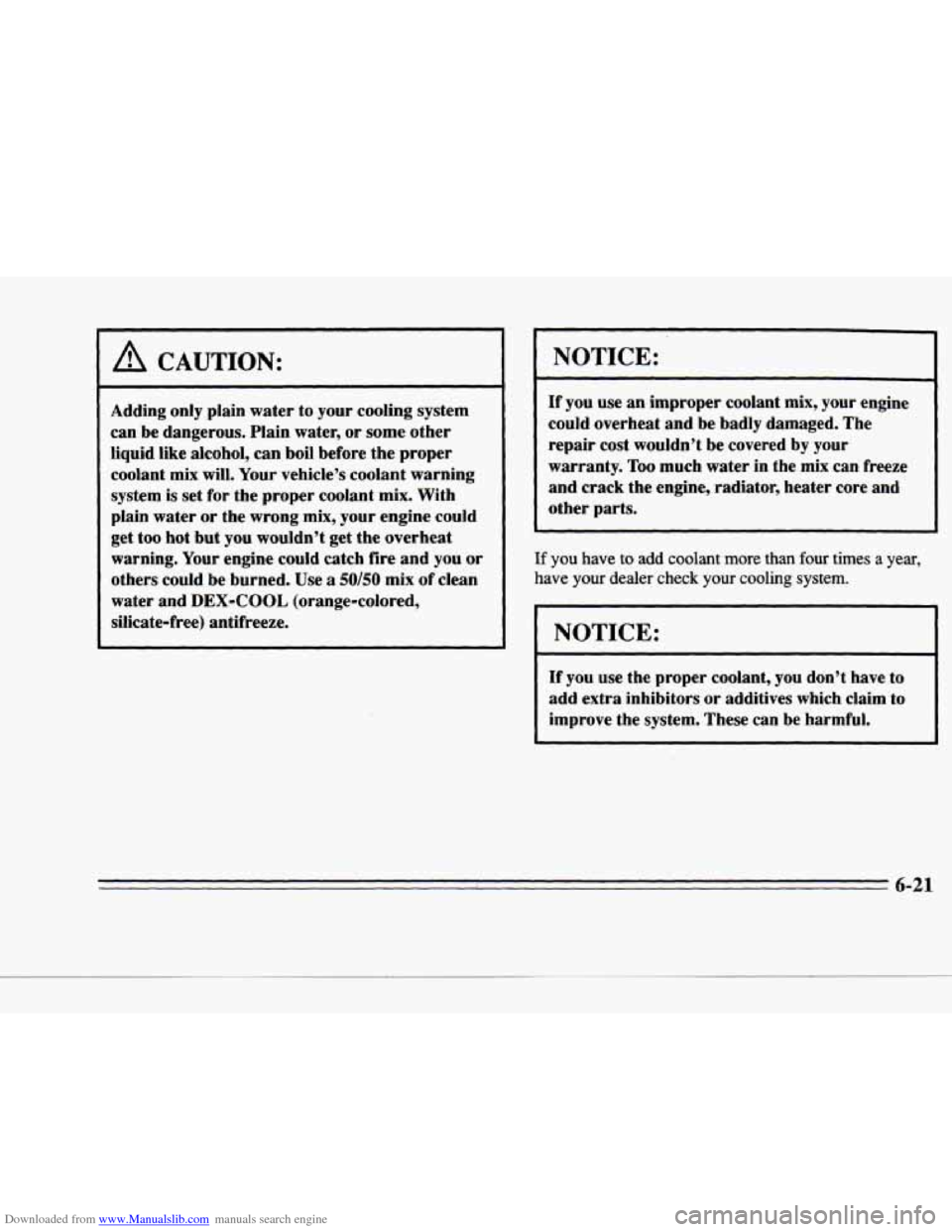
Downloaded from www.Manualslib.com manuals search engine c
c
L
A CAUTION:
Adding only plain water to your cooling system
can be dangerous. Plain water, or
some other
liquid like alcohol, can boil before the proper
coolant mix will. Your vehicle’s coolant warning
system is set for the proper coolant mix. With
plain water
or the wrong mix, your engine could
get too hot but you wouldn’t get the overheat
warning. Your engine could catch fire and you
or
others could be burned. Use a 50/50 mix of clean
water and
DEX-COOL (orange-colored,
silicate-free) antifreeze.
NOTICE:
If you use an improper coolant mix, your engine
could overheat and be badly damaged. The
repair cost wouldn’t be covered by your
warranty.
Too much water in the mix can freeze
and crack the engine, radiator, heater core and
other parts.
[f you have to add coolant more than four times a year,
lave your dealer check your cooling system.
NOTICE:
If you use the proper coolant, you don’t have to
add extra inhibitors or additives which claim to
improve the system. These can be harmful.
Page 283 of 354
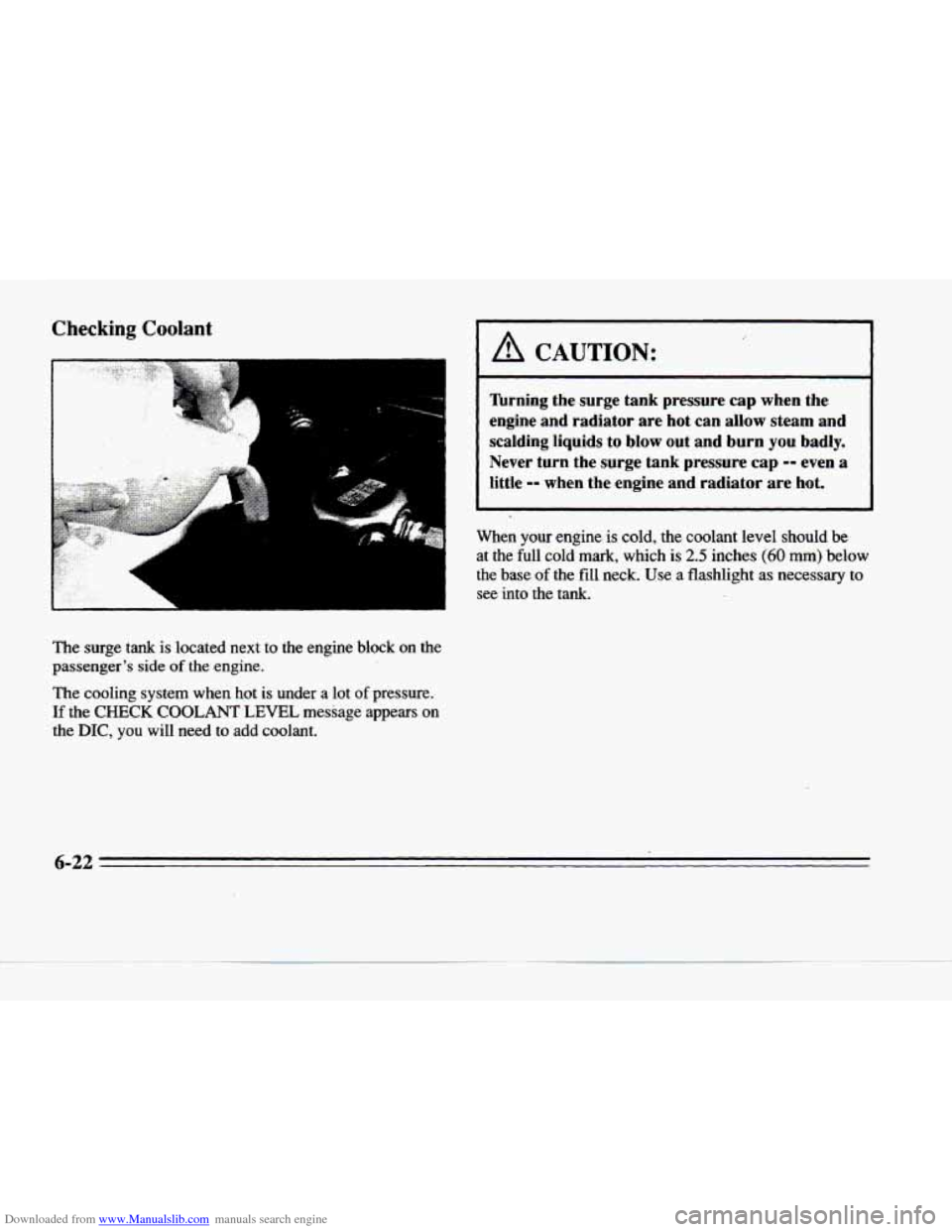
Downloaded from www.Manualslib.com manuals search engine Checking Coolant
.
The surge tank is located next to the engine block on the
passenger’s side of the engine.
The cooling system when hot is under a lot of pressure.
If the CHECK COOLANT LEVEL message appears on
the
DIC, you will’need to add coolant.
A CAUTION:
I’urning the surge tank pressure cap when the
engine and radiator are hot can allow steam and
scalding liquids to blow out and burn you badly. Never turn the surge tank pressure cap
-- even a
little
-- when the engine and radiator are hot.
When your engine is cold, the coolant level should be
at the full cold mark, which is 2.5 inches (60 mm) below
the
base of the fill neck. Use a flashlight as necessary to
see into the tank.
Page 284 of 354
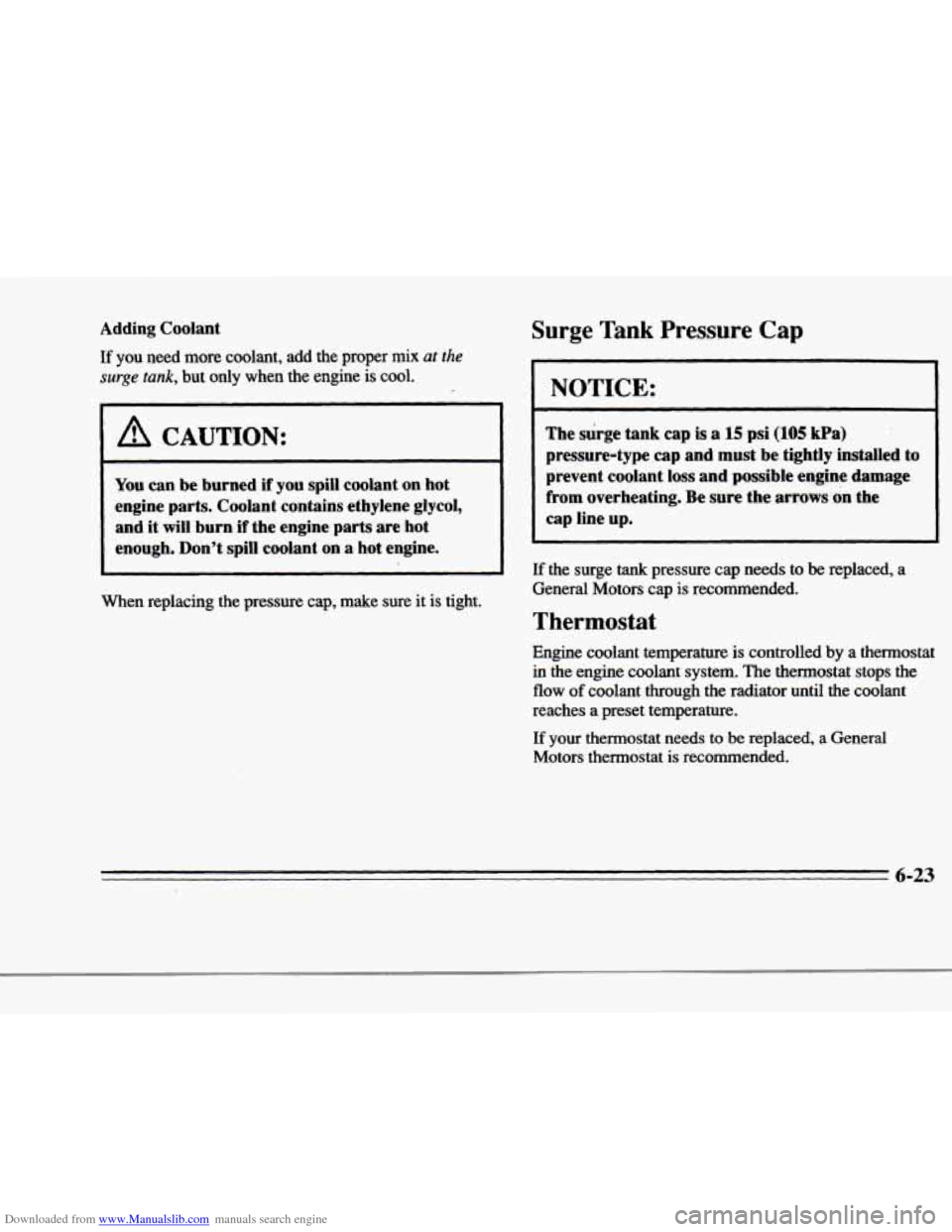
Downloaded from www.Manualslib.com manuals search engine hl
r
r
f
P
6'
r
Adding Coolant
If you need more coolant, add the proper mix at the
surge tank, but only when the engine is cool.
I A CAUTION:
You can be burned if you spill coolant on hot
engine parts. Coolant contains ethylene glycol,
and
it will burn if the engine parts are hot
enough. Don't spill coolant on a hot engine.
~~~ ~ ~~~~~~~
When replacing the pressure cap, make sure it is tight.
Surge Tank Pressure Cap
I NOTICE:
The surge tank cap is a 15 psi (105 kPa)
pressure-type
cap and must be tightly instalfed to
prevent coolant loss and possible engine damage
from overheating. Be sure
the arrows on the
cap line up.
If the surge tank pressure cap needs to be replaced, a
General Motors cap
is recommended.
Thermostat
Engine coolant temperature is controlled by a thermostat
in the engine coolant system. The thermostat stops the
flow of coolant through the radiator until the coolant
reaches a preset temperature.
If your thermostat needs to be replaced, a General
Motors thermostat
is recommended.
Page 285 of 354
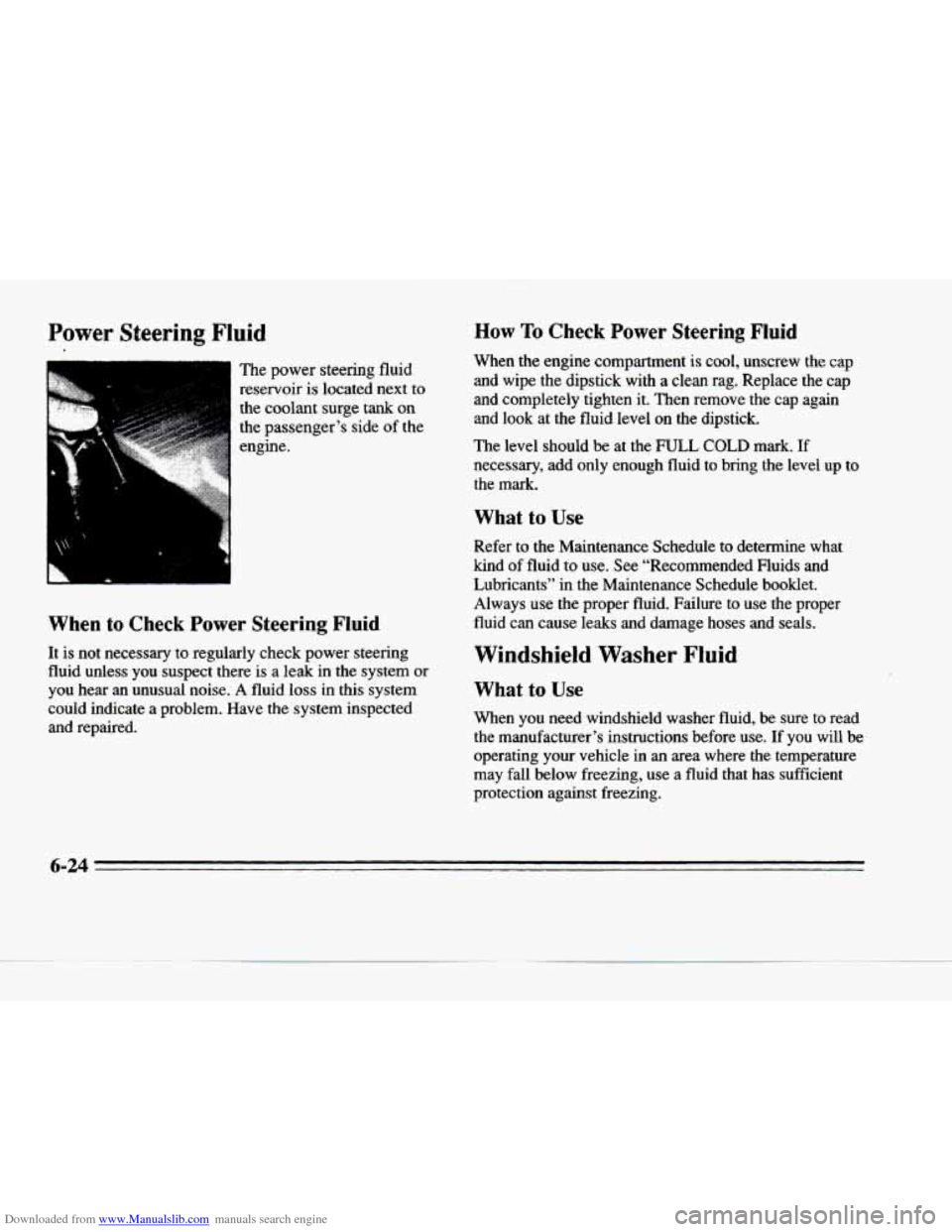
Downloaded from www.Manualslib.com manuals search engine Power Steering Fluid
The power steering fluid reservoir
is located next to
the coolant surge tank on
When to Check Power Steering Fluid
It is not necessary to regularly check power steering
fluid unless you suspect there is a leak in the system or
you hear an unusual noise.
A fluid loss in this system
could indicate a problem. Have the system inspected
and repaired.
How To Check Power Steering Fluid
When the engine compartment is cool, unscrew the cap
and wipe the dipstick with a clean rag. Replace the cap
and completely tighten it. Then remove the cap again
and look at the fluid level on the dipstick.
The level should be at the
FULL COLD mark. If
necessary, add only enough fluid to bring the level up to
the mark.
What to Use
Refer to the Maintenance Schedule to determine what
kind of fluid to use. See “Recommended Fluids and
Lubricants” in the Maintenance Schedule booklet.
Always use the proper fluid. Failure to use the proper
fluid can cause leaks and damage hoses and seals.
Windshield Washer Fluid
What to Use
When you need windshield washer fluid, be sure to read
the manufacturer’s instructions before use. If you will be
operating your vehicle
in an area where the temperature
may fall below freezing, use a fluid that has sufficient
protection against freezing.
6-24
*-
1
Page 286 of 354
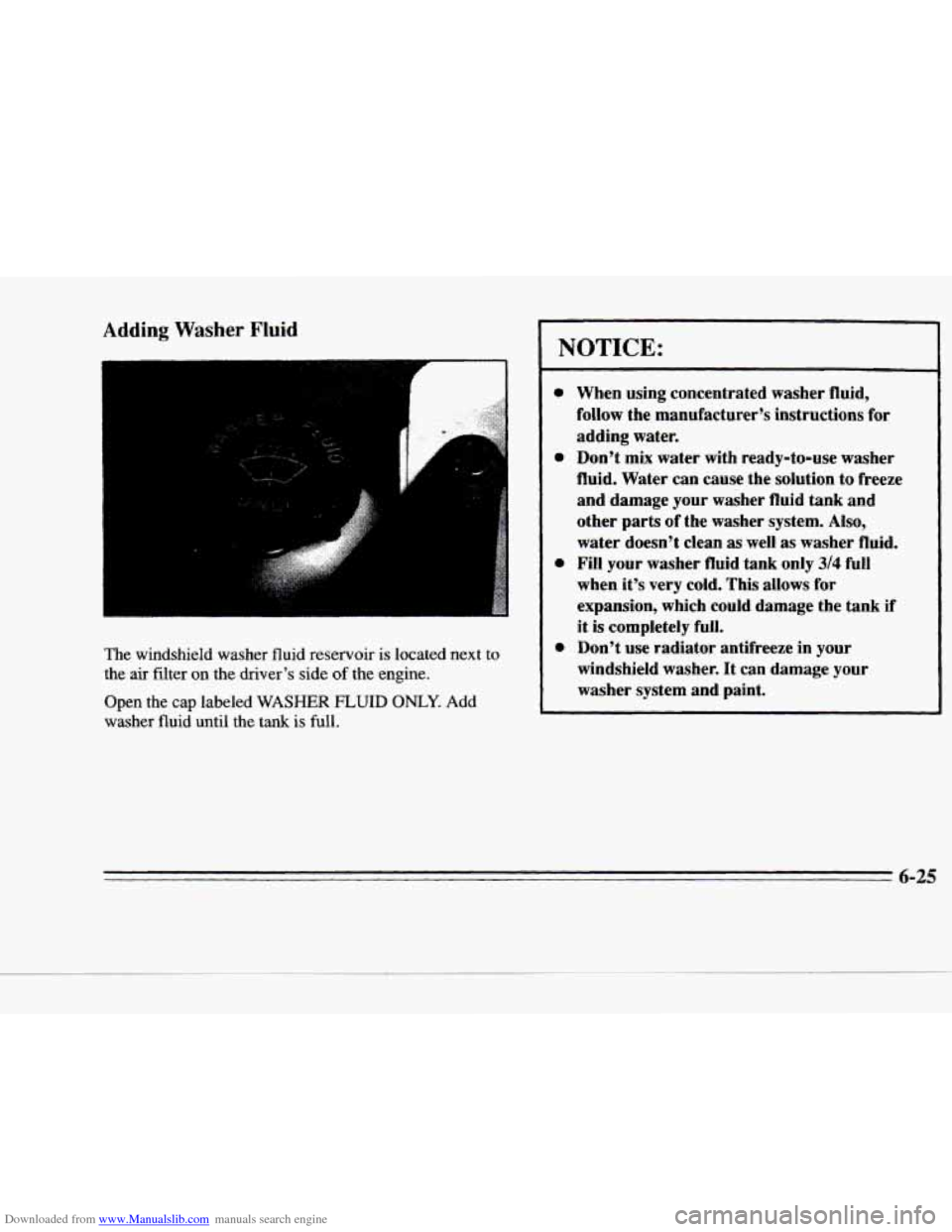
Downloaded from www.Manualslib.com manuals search engine C
c
Adding Washer Fluid
The windshield washer fluid reservoir is located next to
the air filter on the driver’s side
of the engine.
Open the cap labeled WASHER
FLUID ONLY. Add
washer fluid until the tank
is full.
NOTICE:
0
0
0
e
When using concentrated washer fluid,
follow the manufacturer’s instructions
for
adding water.
Don’t mix water with ready-to-use washer
fluid. Water can cause
the solution to freeze
and damage
your washer fluid tank and
other parts of the washer system. Also,
water doesn’t clean
as well as washer fluid.
Fill your washer fluid tank only
314 full
when
it’s very cold. This allows for
expansion, which could damage the tank if
it is completely full.
Don’t use radiator antifreeze in
your
windshield washer. It can damage your
washer system and paint.
6-25
c
Page 287 of 354
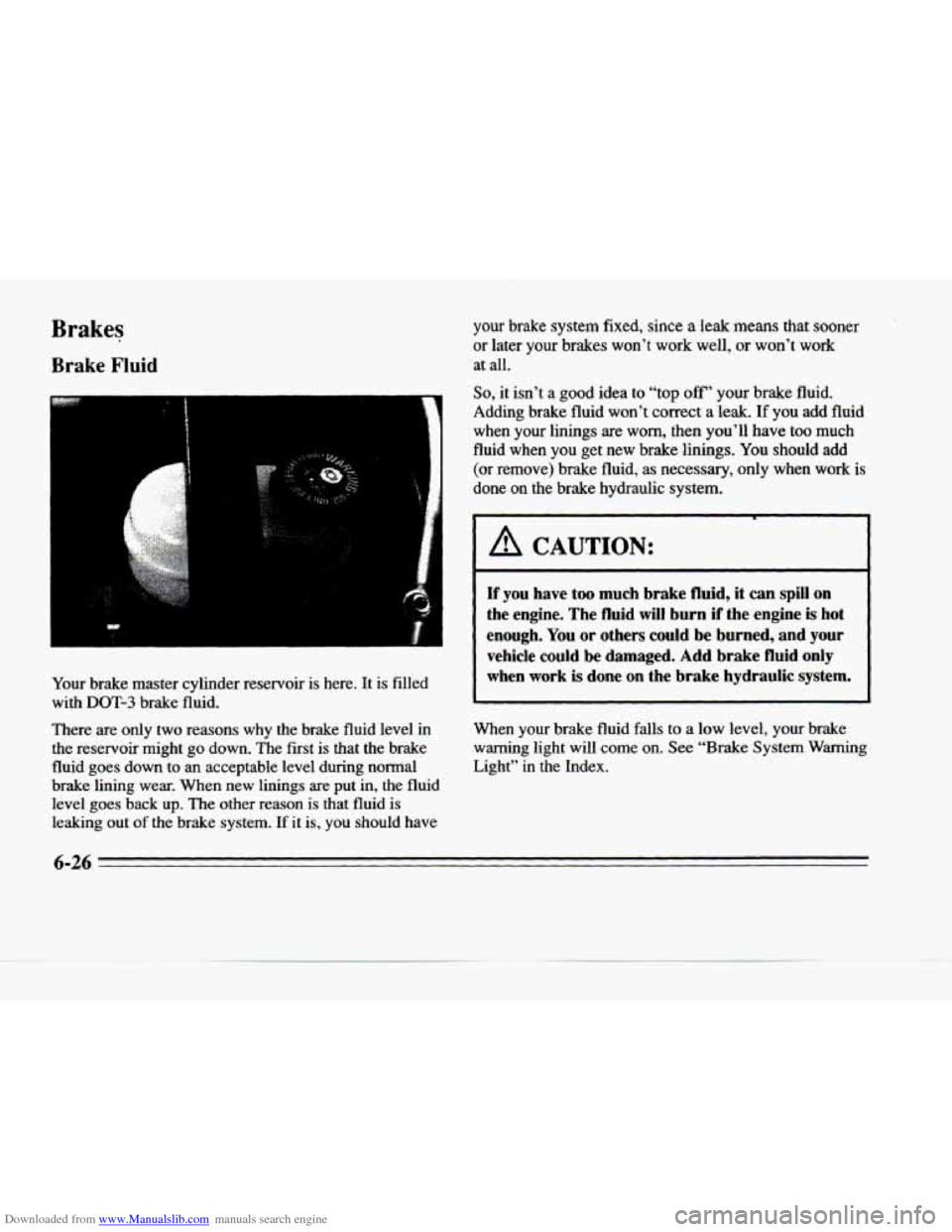
Downloaded from www.Manualslib.com manuals search engine Brakes
Brake Fluid
i
... : .:...:.:: . :; -,.:,.::;
Y
Your brake master cylinder reservoir is here. It is filled
with
DOT-3 brake fluid.
There are only two reasons why the brake fluid level in the reservoir might go down. The first is that the brake
fluid goes down
to an acceptable level during normal
brake lining
wear. When new linings are put in, the fluid
level goes
back up. The other reason is that fluid is
leaking out of
the brake system. If it is, you should have your brake system fixed, since
a leak means that sooner
or later
your brakes won't work well, or won't work
at all.
So, it isn't a good idea to "top off' your brake fluid.
Adding brake fluid won't correct
a leak. If you add fluid
when
your linings are worn, then you'll have too much
fluid when you get new brake linings. You should add
(or remove) brake fluid, as necessary, only when work is
done on
the brake hydraulic system.
I A CAUTION:
If you have too much brake fluid, it can spill on
the engine. The fluid will burn if the engine
is hot
enough. You or others could be burned, and your
vehicle could
be damaged. Add brake fluid only
when work
is done on the brake hydraulic system.
When your brake fluid falls to a low level, your brake
warning light will come on. See "Brake System Warning
Light"
in the Index.
c
6-26
Page 288 of 354
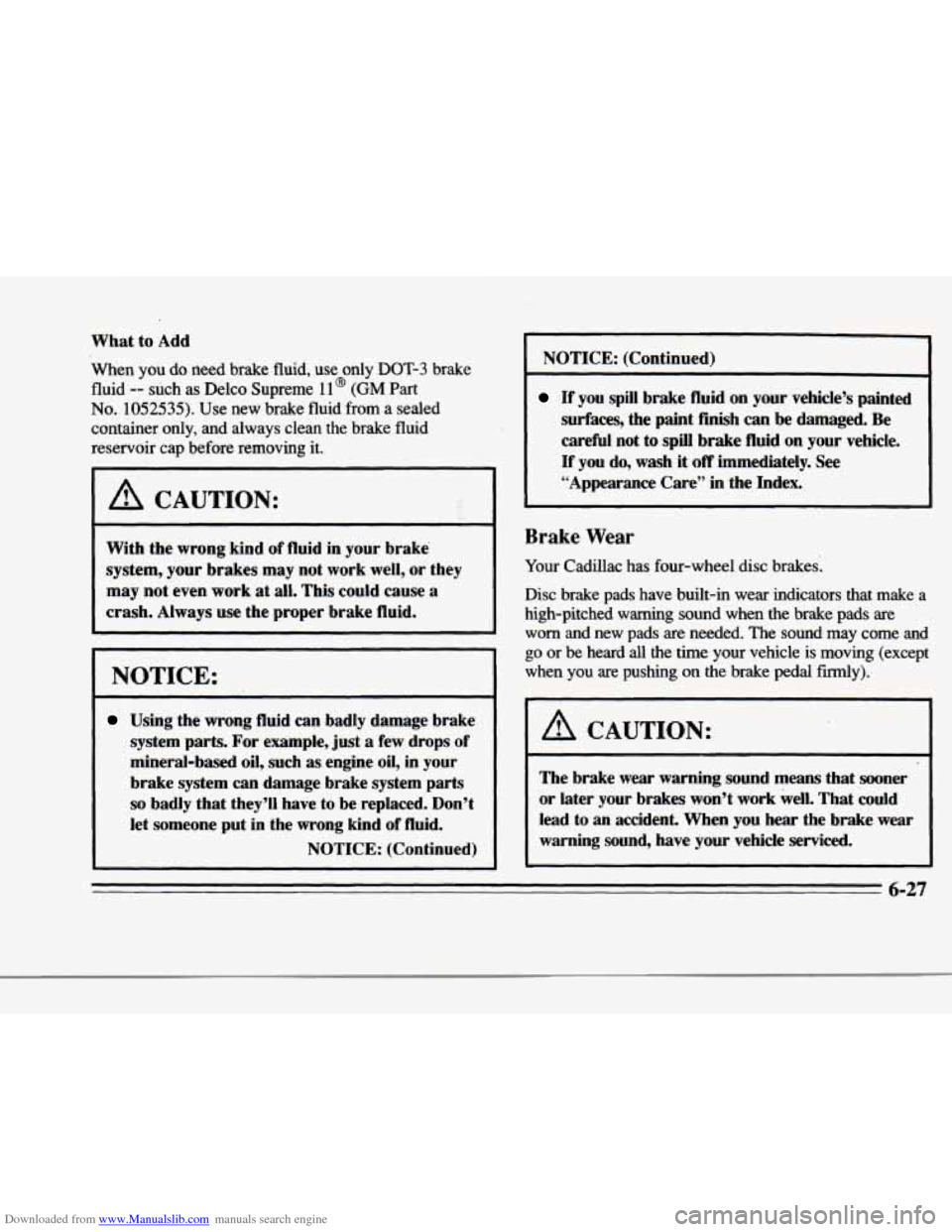
Downloaded from www.Manualslib.com manuals search engine r
Q
r
p“
f I
r
What to ,Add
When
you do need brake fluid, use only DOT-3 brake
fluid
-- such as Delco Supreme 11@ (GM Part
No. 1052535). Use new brake fluid from a sealed
container only,
and always clean the brake fluid
reservoir cap before removing
it.
A CAUTION:
With the wrong kind of fluid in your brake
system, your brakes
may not work well, or they
may not even work
at all. This could cause a
crash. Always use the proper brake fluid.
Using the wrong fluid can badly damage brake
system parts. For example, just
a few drops of
mineral-based oil, such as engine oil, in your
brake system can damage brake system
parts
so badly that they’ll have to be replaced. Don’t
let someone put in the wrong kind
of fluid.
NOTICE: (Continued) NOTICE:
(Continued)
If you spill brake fluid on your vehicle’s painted
surfaces, the paint finish can
be damaged. Be
carefbl not to spill brake
fluid on your vehicle.
If you do, wash it off immediately. See
“Appearance Care” in the Index.
Brake Wear
Your Cadillac has four-wheel disc brakes.
Disc brake pads have built-in wear indicators that make
a
high-pitched warning sound when the brake pads are
worn
and new pads are needed. The sound may come and
go or be heard all the time your vehicle is moving (except
when you are pushing on the brake
pedal fmly).
A CAUTION:
The brake wear warning sound means that sooner
or later your brakes won’t work well. That could
lead to
an accident. When you hear the brake wear
warning sound, have your vehicle serviced.
6-27
r
I
Page 289 of 354
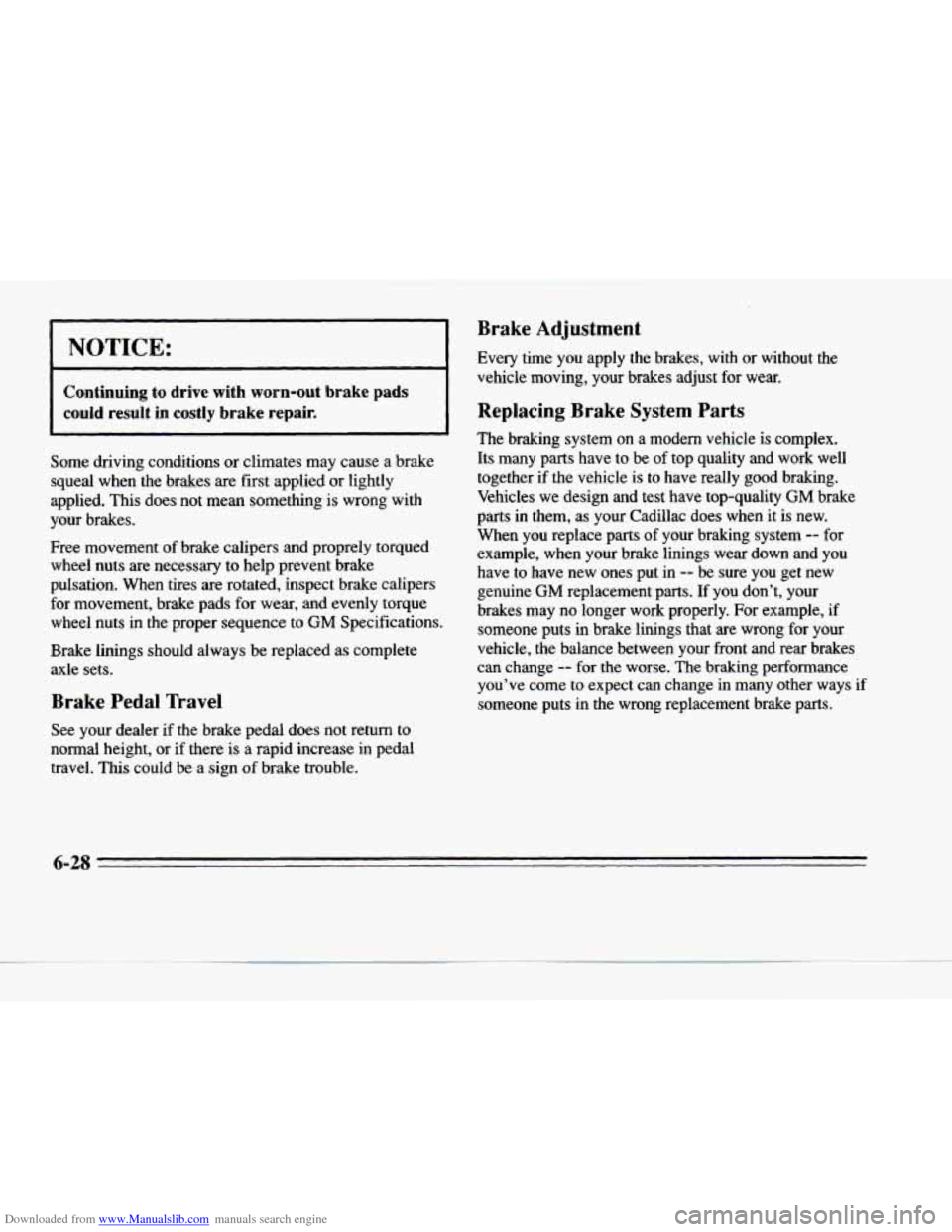
Downloaded from www.Manualslib.com manuals search engine I NOTICE:
Continuing to drive with worn-out brake pads
could result
in costly brake repair.
Some driving conditions or climates may cause a brake
squeal when the brakes are first applied
or lightly
applied. This does not mean something is wrong with
your brakes.
Free movement of brake calipers and proprely torqued
wheel nuts are necessary
to help prevent brake
pulsation. When tires are rotated, inspect brake calipers
for movement, brake pads for wear, and evenly torque wheel nuts in the proper sequence to
GM Specifications.
Brake linings should always
be replaced as complete
axle sets.
Brake Pedal Travel Brake Adjustment
Every time you apply the brakes, with
or without the
vehicle moving,
your brakes adjust for wear.
Replacing Brake System Parts
The braking system on a modem vehicle is complex.
Its many parts have to
be of top quality and work well
together if the vehicle
is to have really good braking.
Vehicles
we design and test have top-quality GM brake
parts in them, as your Cadillac does when it is new.
When you replace
parts of your braking system -- for
example, when your brake linings wear down and you
have to have new ones put in
-- be sure you get new
genuine
GM replacement parts. If you don’t, your
brakes may no longer work properly. For example, if
someone puts in brake linings that are wrong for your
vehicle, the balance between your front and rear brakes
can change -- for the worse. The braking performance
you’ve come to expect can change in many other ways if
someone puts in the wrong replacement brake
parts.
--
See your dealer if the brake pedal does not return to
normal height,
or if there is a rapid increase in pedal
travel.
This could be a sign of brake trouble.
6-28
Page 290 of 354
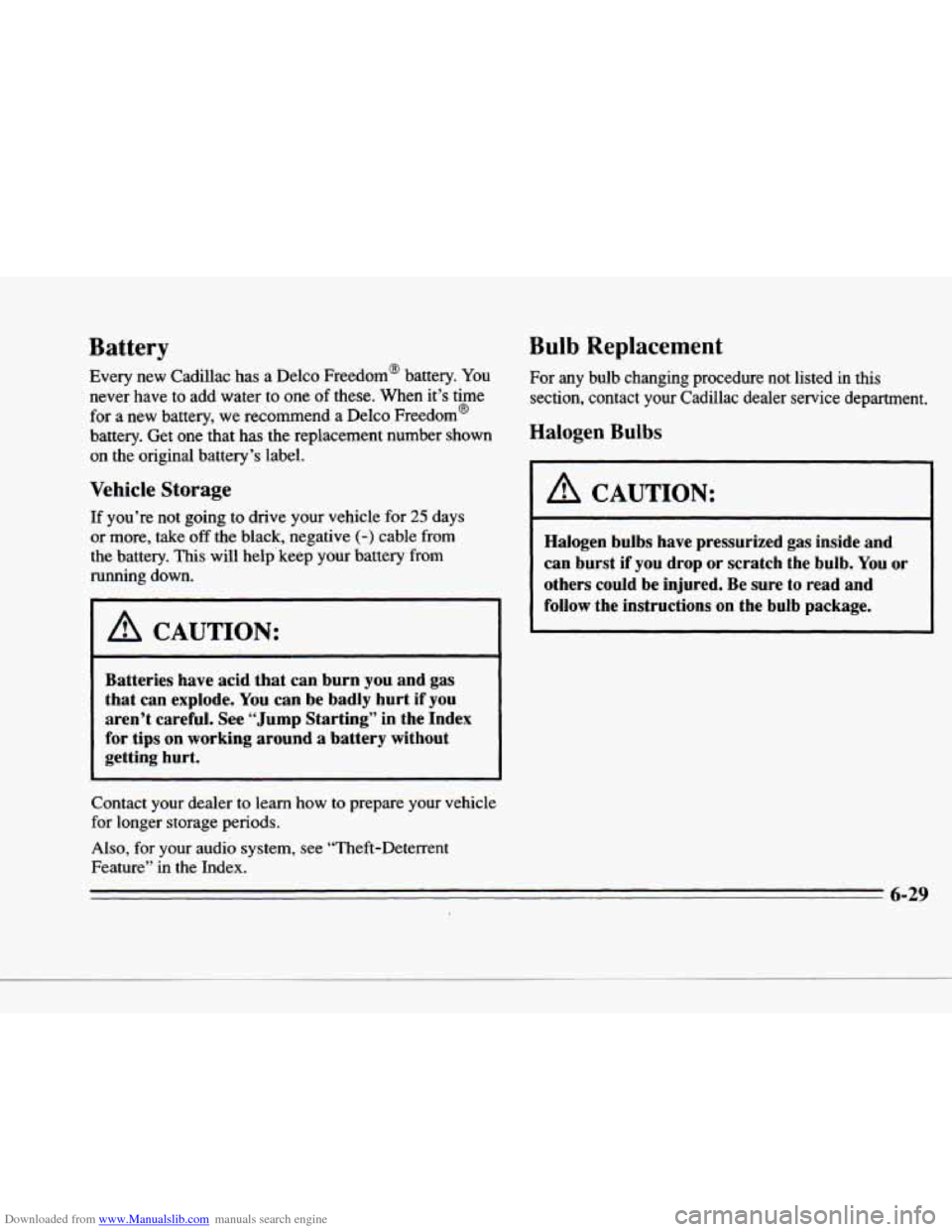
Downloaded from www.Manualslib.com manuals search engine c
P
c
L-
Battery
Every new Cadillac has a Delco Freedom@ battery. You
never have to add water to one of these. When it’s time
for a new battery, we recommend a Delco Freedom@
battery. Get one that has the replacement number shown
on the original battery’s label.
Vehicle Storage
If you’re not going to drive your vehicle for 25 days
or more, take
off the black, negative (-) cable from
the battery.
This will help-keep your battery from
running down.
1 A CAUTION:
Batteries have acid that can burn you and gas
that can explode.
You can be badly hurt if you
aren’t careful. See
“Jump Starting” in the Index
for tips
on working around a battery without
getting hurt.
Contact your dealer
to learn how to prepare your vehicle
for longer storage periods.
Also, for your audio system, see “Theft-Deterrent
Feature’’ in the Index.
Bulb Replacement
For any bulb changing procedure not listed in this
section, contact your Cadillac dealer service department.
Halogen Bulbs
A CAUTION:
Halogen bulbs have pressurized gas inside and
can burst
if you drop or scratch the bulb. You or
others could be injured. Be sure to read and
follow the instructions on the bulb package.